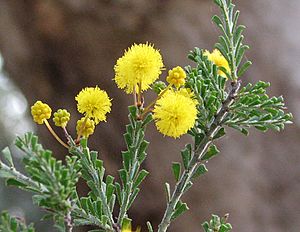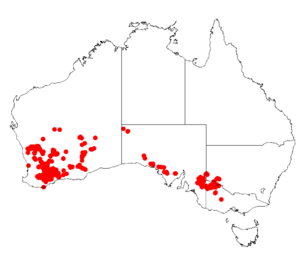Harrow wattle facts for kids
Quick facts for kids Harrow wattle |
|
|---|---|
 |
|
| Scientific classification | |
| Genus: |
Acacia
|
| Species: |
acanthoclada
|
 |
|
| Occurrence data from AVH | |
The Acacia acanthoclada, also known as the harrow wattle, is a special type of shrub. It grows low to the ground and has many branches. Its branches are often spiky. This plant is found only in Australia, meaning it is endemic there.
Contents
What Does the Harrow Wattle Look Like?
This shrub can grow up to 2 metres (about 6.5 feet) tall. It has unique leaf-like structures called phyllodes. These phyllodes are small, usually 0.2 to 0.6 centimetres long and 1 to 2 millimetres wide. They are straight and narrow, with a small notch at the tip. Each phyllode has a clear vein in the middle.
The young branches are whitish and covered in tiny hairs. As they grow older, they become smooth and end in a stiff, sharp point, like a spine. The bark of the plant can be grey, white, or sometimes a bit greenish.
Flowers and Seed Pods
The harrow wattle produces beautiful golden-yellow flowers. These flowers grow on stalks called peduncles, which are 5 to 15 centimetres long. The flowers appear where the phyllodes meet the stem, a spot called the axil.
Each flower has five parts. The sepals, which are like small leaves protecting the bud, are joined together to form a cup-like structure called a calyx. You can see these flowers from August to October. After the flowers, the plant grows brown seed pods. These pods are usually twisted and have a slightly bluish-green look. They are about 3 to 6 centimetres long and 3 to 6 millimetres wide.
How the Harrow Wattle Was Named
The harrow wattle was officially described in 1863. A botanist named Ferdinand von Mueller gave it its scientific name. He was the Victorian Government Botanist at the time. He wrote about it in his book, Fragmenta Phytographiae Australiae. He studied plants he found near a place called Kulkyne, Victoria.
Different Kinds of Harrow Wattle
Scientists recognize two main types, or subspecies, of the harrow wattle:
- A. acanthoclada F.Muell. subsp. acanthoclada
- A. acanthoclada subsp. glaucescens Maslin
Where Does the Harrow Wattle Grow?
This plant is not very common. You can find it scattered in a few places across Australia. It grows in isolated groups in:
- Far south-western New South Wales, in areas like Buronga, Wentworth, and Pooncarie.
- Parts of Victoria.
- Areas of South Australia.
- Specific locations in Western Australia, such as Arumpo Station and Montarna Station.
At Arumpo Station, some harrow wattles are smaller than usual. They are in danger because too many kangaroos are eating them. This is called overgrazing.
Where Does the Harrow Wattle Live?
The harrow wattle usually prefers to grow in deep, loose, sandy soil. It likes areas that have not been disturbed by people. You can often find it in mallee areas, which are types of Australian bushland. It often grows on sandy ridges and dunes. Sometimes, but less often, it can be found growing on rocky areas.
See also
 In Spanish: Acacia acanthoclada para niños
In Spanish: Acacia acanthoclada para niños

